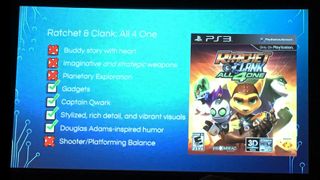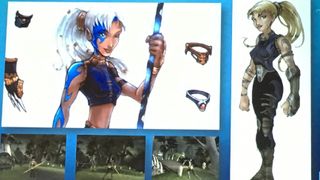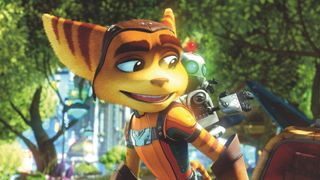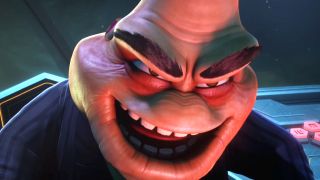“We made a four-page manual on crate stacking”: Ratchet and Clank’s creators on the lessons of their 15-year success story
Insomniac share the secrets of building a franchise, and the tension between making – and breaking – your own rules

Ratchet and Clank’s creators shared the highs and lows of their 15-year-history in one of the warmest and most insightful talks we saw at GDC 2018. Their one-hour presentation was a candid insight into how to build a (mostly) successful franchise; from the game’s beginnings as the ‘girl with the stick’, to being given a legal scare by a nursery rhyme. A mix of practical advice, unseen concept art, and confessions, it was one of the funniest, most meticulously constructed, talks we saw at the Games Developers Conference in San Francisco.
The Ratchet and Clank series spans 14 games, with some unusual highs and lows. “After about six years, we’d seen a number of changes to the development team, and a lot of the new designers didn’t really know how to design a stack of crates”, said director Brian Allgeier. This led chief creative officer Brian Hastings to draft a four-page document on the art of stacking crates. Unusual as it sounds, smashing up crates to release a shower of collectible bolts is one of the game’s small joys that benefits from a set of design rules. For example, they created guidelines for the shape of the stack, the number of the crates, when to include exploding boxes (to encourage use of your wrench as a projectile)… each little detail contributing to the game’s feel.

Insomniac improvised the early games, with little attention to the game’s lore or unspoken brand rules. The team designed 60 guns for PS2’s original Ratchet and Clank in 2002, but later discovered that weapons needed a strategic use for players to engage with them. Looking cool wasn’t enough. For Ratchet and Clank: Tools of Destruction the team established three criteria for new weapons: Comedic, Strategic and Spectacle. If a weapon wasn’t a 10/10 on one aspect, it didn’t get used – leading to iconic guns such as the Groovitron, which released a glitter ball causing enemy characters to dance. After a number of sequels, Insomniac created brand values that each game needed to hit. An experimental entry in the series like All 4 One deviated a little too far from core values, Insomniac reflected, but the studio never lost their appetite for taking risks, having defined the core of what made their games tick.

In 2000, Ratchet and Clank began life as the ‘the girl with the stick’ as the concept sketches below illustrate. The developers took us back to the early 00's via a montage of a Nokia 3310 phone, Perfect Dark on N64 and a picture of George Bush. Insomniac wanted to create a deeper experience than their popular PS One series Spyro the Dragon, but little took shape until creative director Brian Hastings summarised the intent as ‘an alien that travels from planet to planet collecting weapons and gadgets’.
Other influences included The Little Prince, Marvin the Martian, The Iron Giant, Super Mario 64 and The Legend of Zelda. Ratchet’s appearance slowly took shape, with president Ted Price once describing him as a ‘Lombax’, which stuck. Clank was originally designed as a factory defect, with an English child’s voice, like C-3PO but it just didn’t work. The duo evolved as the intergalactic buddy movie concept took shape, dubbed ‘Lethal Weapon meets Saturday morning cartoons’.

The original Ratchet and Clank was a success, although Insomniac reflected Ratchet was ‘kind of a jerk’ and toned back the sarcasm for later games. This taught the studio a valuable lesson that they’ve upheld to this day, which could be attributed to the failure of so many other games to create characters. Namely, to develop your heroes and their relationships, since if the audience doesn’t care about them, they won’t care about your world. As time wore on, games with mascots (like Sonic, Spyro, Gex, Dr Muto, Bubsy etc) started to wane in popularity. What allowed Ratchet and Clank to endure where other failed? Insomniac felt Ratchet and Clank survived since the game evolved from a platformer with shooting, to a shooter with platforming.
The difficult fourth game… and how losing its way allowed Ratchet to better define its appeal
The challenge of creating a fourth game, and a desire to innovate, led to one of the worst-received Ratchet games ever: Ratchet Deadlocked. Insomniac had become obsessed by Halo, and unwisely decided to ‘go dark’, losing Ratchet’s core appeal – and sidelining Clank almost entirely. One critic billed the game as ‘soulless gun porn’. Insomniac took the lesson, doubling down on the ‘Franchise DNA’ to inform later entries in the series. The leap to new console hardware on PS3, with Ratchet and Clank Future: Tools of Destruction, was another gamble that almost disrupted the game’s core appeal. Giddy with PS3’s new technical horizons, the team wanted to make a CG-style animated movie, including procedurally generated planets and open space exploration. The team, wisely, dialled back their ambitions (but would revisit them later in the series), after one team member began his contribution to an ideas meeting by writing ‘Technology is evil’ on a wipe board.
Sign up to the GamesRadar+ Newsletter
Weekly digests, tales from the communities you love, and more

At this point, the team were joined by writer T.J. Fixman who was brought in to unify the series’ lore and create new plot threads. Fans wanted answers to questions, from oddities such as ‘Is Clank the only sentient robot in the universe?’ to bigger issues like ‘Who is Ratchet?’. This led to a unified mythology and new threads such as the Zoni, Terachnoid Sage and Court of Azimuth. Insomniac created a new rule to ‘Embrace World building’, with games needing to define the emotional backstories (since players want to see themselves in their heroes), set new mythology branches (to explore in future games), be specific and to write for hardcore gamers. “It’s easy to say people won’t notice”, said Fixman, “But they will! They will eviscerate or evangelise”. Insomniac doubled down on details, which was reflected in the polish of their GDC 2018 presentation.

More experiments followed, including the creation of one of the world’s first digital-only DLC titles, Quest for Booty. This allowed the team to resolve a massive plot cliff hanger from the previous game (Clank’s abduction by the Zoni, which left fans upset they’d have to wait years for answers), explore RPG-style NPC conversation trees, plus trial new gameplay mechanics (like the wrench tether puzzles) in a shorter, more experimental, format. Quest for Booty’s smaller development team and shorter length meant it was one of the series' biggest returns on investment… although a nursery rhyme almost ruined it. Fixman thought it would be fun to have a character who says “I’m a little teapot” every time he opened a door… until lawyers representing that nursery rhyme got in touch. The team settled up and took the lesson.

The Ratchet and Clank series developed a love for mischievous pun subtitles, from Up Your Arsenal to Quest for Booty. All 4 One's original subtitle was 4 Play, Insomniac revealed, which was unsurprisingly rejected, before writer T.J. Fixman suggested 'Multiple Organisms'. "That was the fastest 'no' ever", he admitted.
Insomniac continued to learn the hard way after killing off series’ favourite Dr. Nefarious in A Crack in Time, which they thought was their last R&C game. Mindful of a spectacular send off, they smashed Dr Nefarious into his own space station, which duly exploded. Typically, the desire for sequels led to Sony asking Insomniac to resurrect their arch villain a few years later. “We just flew that dude into a space station!” said Fixman. “Maybe it was a flesh wound?”, replied the Sony exec. Never ring a bell if there’s chance a publisher may want it un-rung, noted Fixman, who had to ret-con Dr. Nefarious’ demise in a graphic novel. The arch villain had escaped just before impact, it turned out (“Not my most elegant solution”, said Fixman).
The Ratchet and Clank movie and the perils of Hollywood script doctors
Following sequels hit a lull, before the spectacular Ratchet and Clank on PS4 (2015), a ‘re-imagination’ of the series referred to internally as ‘the game of the movie based on the game’. Fixman had written the original movie script (a big budget affair starring Sly Stallone, John Goodman and Rosario Dawson), but it had been changed so much by Hollywood writers and execs that the lore was no longer compatible and making a game of the movie proved difficult. Insomniac solved this problem by telling the story via an unreliable narrator, so they could side-step plot inconsistencies as they arose, with the charismatic, deluded Captain Qwark the ideal fit for the role.

Insomniac's GDC 2018 session was generously received by a crowd including PS4 designer and former Insomniac producer Mark Cerny – even after the presentation hit early technical difficulties when a video failed to play three times before flashing up a picture of George Bush. Insomniac's self-deprecating reaction to this technical hiccup spoke to the values that have served the series so well, which – as we discovered – began life when George Bush was US president and Nokia's 3310 phone ruled the world.
The talk concluded to warm applause, with some interesting takeaways for all sequels and ongoing franchises. Ratchet and Clank’s adherence to rules, explicit lore and eye for detail were paramount to its enduring appeal, but tempered with a will to experiment – even when those risks didn’t always pay off. More often than not, imperfect gameplay mechanics were integrated more successfully later in the series, when technology was more powerful – for example, the spherical planets and space exploration. Through 15 years of highs and lows, Ratchet and Clank’s success appears to have stemmed from self-awareness – a defining trait of Ratchet himself – and a willingness to take hard decisions. “I wrote about 10,000 lines of dialogue for A Crack in Time”, said Fixman, “And about another 10,000 we cut out”.
Update: This article was amended to attribute the team's creation of 'weapon goals' to Tools of Destruction and not All 4 One as first published.
Don't miss our review of the 'reimagined' Ratchet and Clank on PS4 which is currently available to play for free for PS Plus owners.
FGS Content Director. Former GamesRadar+ EIC, GTAVoclock host, and PSM3 editor; with - *counts on fingers and toes* - 20 years editorial experience. Loves: spreadsheets, Hideo Kojima and GTA.

Oh, that's why the Stellar Blade devs were terrified by demo players: one fan's spent "about 60 hours" maxing Eve's skill tree before the action RPG is even out

A new Taylor Swift song mentions GTA, but some remember it mentioning Baldur's Gate 3, Final Fantasy 14, and more in hilarious Twitter trend
Most Popular





